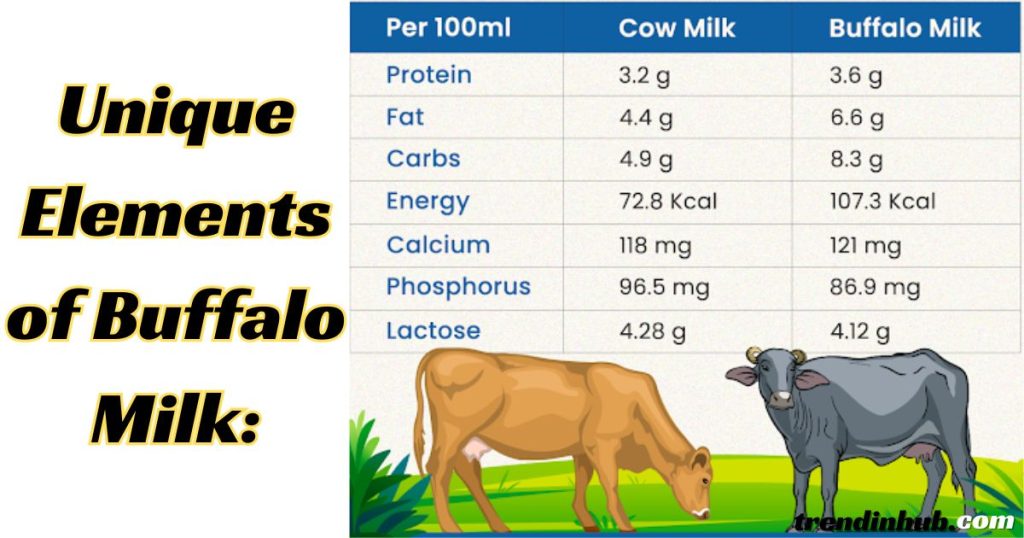1-Introduction to WellHealthOrganic Buffalo Milk Tag:
In today’s health-conscious environment, people are becoming more cautious of their food choices. They search for meals that are not only nutritional but also natural and environmentally beneficial. WellHealthOrganic meets this demand with its WellHealthOrganic Buffalo Milk Tag label, which provides a premium dairy experience distinguished by its purity, nutritional content, and sustainable production techniques.
Table of Contents
2-What is WellHealthOrganic Buffalo Milk Tag?
In the ever-evolving landscape of dietary choices, the demand for pure, nutritious, and organic food options has never been higher. WellHealthOrganic Buffalo Milk Tag emerges as a standout product in this context, offering a unique blend of health benefits, rich flavor, and sustainable farming practices. This comprehensive guide aims to explain what WellHealthOrganic Buffalo Milk Tag is, why it is beneficial, and how it can be a game-changer in your quest for wellness.
Understanding WellHealthOrganic Buffalo Milk Tag
WellHealthOrganic Buffalo Milk Tag is a premium dairy product derived from buffalo milk, distinct from the more commonly consumed cow milk. This milk is sourced from buffaloes that are raised on organic farms, ensuring that the product is free from harmful chemicals, antibiotics, and synthetic hormones. The brand’s commitment to purity and natural living is evident in every drop of their buffalo milk.
Buffalo milk, in itself, has a rich history and is known for its superior nutritional profile. It contains higher levels of proteins, calcium, and essential fatty acids compared to cow milk. The creamy texture and robust flavor make it not only a healthier choice but also a more enjoyable one for many.
Unique Nutritional Composition
One of the primary reasons WellHealthOrganic Buffalo Milk Tag stands out is due to its unique nutritional composition. Buffalo milk is significantly richer in proteins and essential nutrients. It contains higher levels of calcium, which is crucial for bone health, and is packed with vitamins such as A and D. This makes it particularly beneficial for growing children, athletes, and individuals looking to boost their overall health.
Moreover, buffalo milk contains less cholesterol and is easier to digest for those who are lactose intolerant, thanks to its lower lactose content. This makes it an excellent alternative for people who struggle with cow milk digestion but still want to enjoy the benefits of dairy.
Health Benefits of Buffalo Milk
Consuming WellHealthOrganic Buffalo Milk can lead to numerous health benefits. The high protein content aids in muscle growth and repair, making it ideal for active individuals and those recovering from injuries. The rich calcium content supports bone density and strength, helping to prevent conditions like osteoporosis.
Buffalo milk is also known for its high content of antioxidants, which help in reducing oxidative stress and inflammation in the body. This can lead to better heart health and overall well-being. Additionally, the milk’s natural fatty acids contribute to healthier skin and hair, providing a beauty boost along with health benefits.
Sustainable Farming Practices
WellHealthOrganic is deeply committed to sustainable farming practices. The buffaloes are raised in an environment free from synthetic pesticides and fertilizers, ensuring that the entire ecosystem is in harmony with nature. This not only results in healthier milk but also supports environmental conservation efforts.
The brand’s focus on ethical farming practices extends to every aspect of their production process, from the humane treatment of animals to the use of eco-friendly packaging. By choosing WellHealthOrganic Buffalo Milk, consumers are also making a choice to support sustainable agriculture and reduce their environmental footprint.
3-Unique Elements of Buffalo Milk:
Buffalo milk, often overshadowed by cow milk, offers a distinct and superior nutritional profile that makes it a valuable addition to the diet. WellHealthOrganic Buffalo Milk Tag brings these benefits to light, presenting a nutritious, organic alternative for dairy consumers.

Rich Nutritional Profile
Buffalo milk boasts a higher protein and calcium content compared to cow milk. Proteins are essential for muscle growth and repair, making buffalo milk an excellent choice for athletes and bodybuilders. The calcium in buffalo milk supports strong bones and teeth, crucial for all age groups but especially important for children and the elderly. Additionally, buffalo milk is rich in vitamins A and D, which enhance immune function, vision, and bone health. Phosphorus, another key mineral in buffalo milk, aids in energy production and the formation of bones and teeth.
Superior Taste and Creaminess
The creamy texture and rich flavor of buffalo milk are standout features. This milk has a higher fat content, contributing to its thick, creamy consistency and a slightly sweeter taste that many find more enjoyable than cow milk. These qualities make buffalo milk a preferred ingredient in the production of gourmet dairy products like cheese, yogurt, and ice cream. The natural fat in buffalo milk enhances the flavor and mouthfeel of these products, providing a luxurious experience for the palate.
Lactose Content and Digestibility
One of the significant advantages of buffalo milk is its lower lactose content. Lactose intolerance affects many people, causing digestive discomfort when consuming dairy. Buffalo milk, with its reduced lactose levels, offers a more digestible alternative, allowing those with lactose intolerance to enjoy dairy products without adverse effects. Furthermore, the protein structure in buffalo milk forms a softer curd in the stomach, aiding digestion and making it gentler on the digestive system.
Health Benefits
Buffalo milk provides numerous health benefits, making it a valuable addition to any diet. The rich nutrient profile supports overall health and well-being. Vitamins A and D found in buffalo milk play crucial roles in maintaining a strong immune system and preventing infections. Additionally, buffalo milk supports cardiovascular health. Despite its higher fat content, the fats in buffalo milk are beneficial for maintaining healthy cholesterol levels. Potassium, another vital component of buffalo milk, helps regulate blood pressure, adding to its heart health benefits.
Organic and Sustainable Farming Practices
WellHealthOrganic ensures that its buffalo milk is produced using sustainable and organic farming practices. This means the buffaloes are raised on farms free from synthetic pesticides and fertilizers, ensuring that the milk is natural and pure. These practices not only enhance the quality of the milk but also contribute to environmental sustainability. By choosing buffalo milk from WellHealthOrganic, consumers support ethical farming practices that benefit the planet.
Culinary Versatility
Buffalo milk’s unique properties make it highly versatile in cooking and baking. Its rich and creamy texture enhances the taste and nutritional value of various recipes. From creamy desserts like ice cream and custards to savory dishes like cheese-based sauces and soups, buffalo milk can be used to create delicious and healthy meals. Its superior creaminess and flavor make it an excellent substitute for cow milk in almost any recipe, offering a gourmet twist to everyday dishes.
Buffalo milk is a nutritious, delicious, and versatile dairy option that offers numerous health benefits. WellHealthOrganic Buffalo Milk Tag leverages these unique elements to provide a high-quality product that supports a healthy lifestyle. By choosing buffalo milk, consumers can enjoy a richer, more flavorful milk that is easier to digest and packed with essential nutrients, all while supporting sustainable and organic farming practices.
4-The Story Behind WellHealthOrganic Buffalo Milk Tag:
WellHealthOrganic Buffalo Milk Tag stands out in the dairy industry not only for its high-quality product but also for the story behind its creation. This story is rooted in a commitment to organic farming, sustainable practices, and a vision for healthier living.
Vision and Mission
The founders of WellHealthOrganic had a clear vision: to provide consumers with a pure and natural dairy product that promotes health and wellness. They believed that the path to well-being begins with what we consume, and this conviction led them to create a product that reflects their commitment to quality and sustainability. Their mission was to redefine the dairy industry by offering buffalo milk that is not only nutritious but also produced in an environmentally responsible manner.
Commitment to Organic Farming
At the core of WellHealthOrganic’s philosophy is a dedication to organic farming. The buffaloes are raised on farms that adhere to strict organic standards, ensuring that the milk is free from synthetic pesticides, fertilizers, and other harmful chemicals. This commitment to organic farming means that the buffaloes graze on natural grass, and their health and well-being are prioritized. The result is milk that is as close to its natural state as possible, offering superior nutritional benefits.
Sustainable Practices
Sustainability is a key aspect of WellHealthOrganic’s operations. The founders understood that producing high-quality buffalo milk should not come at the expense of the environment. Therefore, they implemented sustainable farming practices that conserve water, reduce soil degradation, and preserve biodiversity. These practices ensure that the farming process has a minimal ecological footprint, contributing to the long-term health of the planet.
Ethical Production Methods
WellHealthOrganic is committed to ethical production methods that prioritize animal welfare. The buffaloes are treated with care and respect, ensuring they live in a healthy and stress-free environment. This ethical approach extends to the milking process, where hygiene standards are strictly maintained to ensure the purity and safety of the milk. Each step of the production process is designed to uphold the highest standards of quality and ethics.
Quality Control and Safety
From farm to table, WellHealthOrganic maintains rigorous quality control measures to ensure that their buffalo milk meets the highest standards. Each batch of milk undergoes thorough testing to verify its purity and nutritional content. This dedication to quality control ensures that consumers receive a product that is both safe and of the highest quality.
Community and Consumer Education
The story of WellHealthOrganic also includes a commitment to educating the community and consumers about the benefits of buffalo milk and organic farming. The founders believe that informed consumers are empowered to make healthier choices. Through various initiatives, they raise awareness about the advantages of buffalo milk, sustainable farming practices, and the importance of supporting organic products.
Expansion and Innovation
Since its inception, WellHealthOrganic has continually sought ways to innovate and expand its product line. The founders are always exploring new methods to enhance the nutritional profile of their products and to introduce new offerings that meet the evolving needs of consumers. Their dedication to research and development ensures that WellHealthOrganic remains at the forefront of the organic dairy industry.
5. Nutritional Benefits of Buffalo Milk:
Buffalo milk, like cow’s milk, is a rich source of essential nutrients that are vital for maintaining good health. Here are some key nutritional benefits:

- Protein: Buffalo milk is an excellent source of high-quality protein. Proteins are essential for building and repairing tissues, supporting immune function, and maintaining healthy muscles. Buffalo milk contains all the essential amino acids needed by the body.
- Fat: Buffalo milk typically contains more fat than cow’s milk, making it creamier and richer in taste. The fat content provides essential fatty acids, which are important for brain health, hormone production, and nutrient absorption.
- Calcium: Buffalo milk is a rich source of calcium, which is essential for maintaining strong bones and teeth. Adequate calcium intake is crucial for preventing osteoporosis and promoting overall bone health.
- Vitamins: Buffalo milk contains various vitamins, including vitamin A, vitamin D, and some B vitamins. Vitamin A is essential for vision, skin health, and immune function, while vitamin D is necessary for calcium absorption and bone health. B vitamins play crucial roles in energy metabolism and neurological function.
- Minerals: In addition to calcium, buffalo milk provides other essential minerals such as phosphorus, potassium, magnesium, and zinc. These minerals are involved in various physiological processes, including muscle function, nerve transmission, and fluid balance.
- Conjugated Linoleic Acid (CLA): Buffalo milk contains higher levels of conjugated linoleic acid compared to cow’s milk. CLA is a type of omega-6 fatty acid that has been associated with numerous health benefits, including reduced body fat, improved heart health, and enhanced immune function.
- Antioxidants: Buffalo milk contains antioxidants such as selenium and tocopherols, which help protect cells from damage caused by free radicals. Antioxidants play a crucial role in reducing the risk of chronic diseases and supporting overall health.
Overall, incorporating buffalo milk into your diet can provide a range of essential nutrients that support overall health and well-being. However, it’s essential to consume dairy products in moderation and opt for low-fat or skim varieties if you’re watching your calorie or fat intake.
6. Health Benefits of Buffalo Milk:
- 1. Protein Prowess
Buffalo milk is renowned for its high protein content, making it an excellent source of this essential macronutrient. Proteins are crucial for various bodily functions, including tissue repair, immune support, and muscle maintenance. The protein in buffalo milk contains all the essential amino acids required by the body, making it a complete protein source.
- 2. Nourishing Fats
Unlike cow’s milk, buffalo milk typically contains higher levels of fat. While some might be wary of higher fat content, these fats are beneficial. Buffalo milk is a rich source of essential fatty acids such as omega-3 and omega-6, which are vital for brain health, hormone synthesis, and the absorption of fat-soluble vitamins like A, D, E, and K.
- 3. Bone Boosting Calcium
Buffalo milk is packed with calcium, a mineral essential for building and maintaining strong bones and teeth. Adequate calcium intake is crucial throughout life to prevent conditions like osteoporosis, especially as one ages. Consuming buffalo milk regularly can contribute significantly to meeting daily calcium requirements and supporting overall bone health.
- 4. Vitamin Enrichment
Buffalo milk contains a variety of essential vitamins, each with its own unique benefits:
- Vitamin A: Essential for vision, immune function, and skin health. It also plays a role in cell growth and differentiation.
- Vitamin D: Facilitates the absorption of calcium and phosphorus, promoting bone health and supporting immune function.
- B Complex Vitamins: Includes vitamins such as B2 (riboflavin), B3 (niacin), B5 (pantothenic acid), B6 (pyridoxine), and B12 (cobalamin). These vitamins are crucial for energy metabolism, nerve function, and red blood cell production.
- 5. Mineral Magnificence
Buffalo milk contains a range of essential minerals that are vital for various physiological functions:
- Phosphorus: Important for bone and teeth formation, energy metabolism, and cell membrane structure.
- Potassium: Helps maintain fluid balance, supports muscle function, and plays a role in nerve transmission.
- Magnesium: Necessary for hundreds of enzymatic reactions in the body, including energy production, protein synthesis, and muscle function.
- Zinc: Essential for immune function, wound healing, and DNA synthesis.
- 6. Harnessing CLA
Buffalo milk contains higher levels of conjugated linoleic acid (CLA) compared to cow’s milk. CLA is a type of fatty acid with potential health benefits, including:
- Reduced Body Fat: Some studies suggest that CLA may help reduce body fat mass, particularly abdominal fat.
- Improved Cardiovascular Health: CLA may have a positive impact on cardiovascular health by reducing inflammation and improving lipid profiles.
- Enhanced Immune Function: CLA has been shown to modulate immune function and may help enhance the body’s defense against infections and diseases.
- 7. Antioxidant Armor
Antioxidants found in buffalo milk, such as selenium and tocopherols (vitamin E), play a crucial role in protecting cells from oxidative damage caused by free radicals. These antioxidants help mitigate the risk of chronic diseases such as heart disease, cancer, and neurodegenerative disorders, contributing to overall health and well-being.
7. Organic Farming and Its Impact:
What is Organic Farming?
Organic farming is an agricultural approach that emphasizes sustainable and environmentally-friendly practices. It involves cultivating crops and raising livestock without the use of synthetic pesticides, herbicides, fertilizers, or genetically modified organisms (GMOs). Instead, organic farmers rely on natural methods such as crop rotation, composting, and biological pest control to maintain soil fertility and manage pests.

Key Principles of Organic Farming:
Soil Health:
Organic farming prioritizes soil health as the foundation of sustainable agriculture. Practices such as crop rotation, cover cropping, and the use of organic matter like compost help nourish the soil, enhance its fertility, and promote biodiversity.
Biodiversity Conservation:
Organic farms typically support higher levels of biodiversity compared to conventional farms. By avoiding synthetic chemicals and promoting natural habitats, organic farmers create ecosystems that support diverse plant and animal species.
Animal Welfare:
In organic livestock farming, animals are raised in conditions that prioritize their welfare. They have access to outdoor areas, natural diets, and are not subjected to routine use of antibiotics or growth hormones.
Environmental Sustainability:
Organic farming practices aim to minimize environmental impact by reducing chemical inputs, conserving water and energy, and promoting ecological balance. By adopting agroecological principles, organic farmers contribute to mitigating climate change and preserving natural resources.
Impact of Organic Farming:
Environmental Benefits: Organic farming reduces reliance on synthetic inputs, which can have adverse effects on soil health, water quality, and biodiversity. By promoting natural processes and minimizing pollution, organic agriculture helps conserve ecosystems, protect wildlife habitats, and mitigate climate change.
Health Benefits: Organic foods are free from synthetic pesticides and herbicides, making them a healthier option for consumers. Studies have shown that organic produce tends to have higher levels of antioxidants and lower levels of pesticide residues compared to conventionally grown counterparts, potentially reducing the risk of chronic diseases.
Economic Benefits: While the transition to organic farming may require initial investment and changes in practices, it can lead to long-term economic benefits for farmers. Organic products often command premium prices in the market, and organic farming practices can improve soil fertility, reduce input costs, and enhance resilience to pests and diseases.
Social Benefits: Organic farming fosters stronger connections between farmers and consumers, promoting transparency, trust, and community engagement. By supporting local and sustainable agriculture, consumers contribute to the well-being of rural communities and small-scale farmers.
Challenges and Opportunities:
Despite its many benefits, organic farming also faces challenges such as higher labor costs, limited access to markets, and certification requirements. However, ongoing research, technological innovation, and policy support can help address these challenges and further promote the adoption of organic farming practices.
Organic farming presents opportunities for collaboration between farmers, researchers, policymakers, and consumers to create a more sustainable and resilient food system. By investing in organic agriculture and supporting agroecological approaches, we can build a healthier, more equitable, and environmentally-conscious future.
8. From Farm to Table: The Journey of WellHealthOrganic Buffalo Milk Tag:
. Sustainable Farming Practices:
- The journey begins on WellHealthOrganic farms, where buffalo milk is produced using sustainable and environmentally-friendly farming practices. WellHealthOrganic prioritizes organic farming methods that promote soil health, biodiversity, and animal welfare. This includes providing buffalo with access to open pasture, feeding them organic diets, and avoiding the use of synthetic chemicals.
Ethical Animal Care:
- Buffalo raised on WellHealthOrganic farms are treated with care and respect. They have ample space to roam, access to clean water and nutritious feed, and are not subjected to routine use of antibiotics or growth hormones. WellHealthOrganic prioritizes animal welfare, ensuring that buffalo are healthy, happy, and able to express their natural behaviors.
Milk Production and Collection:
- Once the buffalo are milked, the fresh organic buffalo milk is collected and carefully handled to maintain its quality and freshness. WellHealthOrganic follows strict hygiene and quality control protocols throughout the milk collection process to ensure that consumers receive safe and nutritious products.
Processing and Packaging:
- The collected buffalo milk is transported to WellHealthOrganic’s processing facilities, where it undergoes minimal processing to preserve its natural flavor and nutritional integrity. The milk is pasteurized to ensure food safety while retaining its beneficial nutrients. WellHealthOrganic uses eco-friendly packaging materials to minimize environmental impact.
Distribution and Logistics:
- WellHealthOrganic buffalo milk is then distributed to local markets, grocery stores, and other retail outlets, ensuring easy access for consumers. WellHealthOrganic prioritizes sustainable transportation methods and logistics practices to minimize carbon emissions and reduce its ecological footprint.
Consumer Engagement and Education:
- WellHealthOrganic is committed to engaging with consumers and educating them about the benefits of organic buffalo milk. Through marketing campaigns, educational materials, and community outreach efforts, WellHealthOrganic aims to raise awareness about the importance of sustainable agriculture, animal welfare, and healthy food choices.
Enjoying WellHealthOrganic Buffalo Milk:
- Finally, consumers can enjoy the delicious and nutritious WellHealthOrganic buffalo milk, knowing that it has been produced with care for the environment, animal welfare, and consumer health. Whether enjoyed on its own, added to cereal or smoothies, or used in cooking and baking, WellHealthOrganic buffalo milk offers a wholesome and sustainable option for dairy lovers.
9-Buffalo Milk Recipes for a Healthy Lifestyle
1. Nutrient-Packed Smoothie Bowl:
Start your day with a refreshing smoothie bowl packed with nutrients. Blend together frozen berries, a banana, spinach, and a splash of WellHealthOrganic buffalo milk until smooth. Pour the smoothie into a bowl and top with your favorite toppings such as granola, sliced fruits, nuts, and seeds. Enjoy a colorful and nutritious breakfast that will keep you energized throughout the morning.
2. Creamy Overnight Oats:
Whip up a batch of creamy overnight oats for a quick and nutritious breakfast option. In a jar, combine rolled oats, chia seeds, WellHealthOrganic buffalo milk, a dollop of Greek yogurt, and a drizzle of honey or maple syrup. Stir well, cover, and refrigerate overnight. In the morning, top with fresh fruit, nuts, and a sprinkle of cinnamon for added flavor. These creamy oats are perfect for busy mornings and can be enjoyed on the go.
3. Wholesome Banana Bread:
Indulge in a slice of homemade banana bread made with nutritious ingredients. In a mixing bowl, mash ripe bananas and mix in eggs, WellHealthOrganic buffalo milk, coconut oil, honey, and vanilla extract. In a separate bowl, combine whole wheat flour, baking powder, cinnamon, and a pinch of salt. Gradually add the dry ingredients to the wet ingredients and mix until well combined. Pour the batter into a greased loaf pan and bake until golden brown and cooked through. Slice and enjoy this wholesome treat for breakfast or as a satisfying snack.
4. Creamy Vegetable Soup:
Warm up with a comforting bowl of creamy vegetable soup made with WellHealthOrganic buffalo milk. In a large pot, sauté onions, garlic, carrots, celery, and your favorite vegetables in olive oil until softened. Add vegetable broth and simmer until the vegetables are tender. Use an immersion blender to puree the soup until smooth and creamy. Stir in WellHealthOrganic buffalo milk, season with salt, pepper, and herbs, and simmer for a few more minutes. Serve hot with a sprinkle of grated cheese and crusty bread for a nutritious and satisfying meal.
5. Protein-Packed Pancakes:
Treat yourself to fluffy and protein-packed pancakes made with WellHealthOrganic buffalo milk. In a mixing bowl, whisk together whole wheat flour, baking powder, cinnamon, and a pinch of salt. In a separate bowl, whisk together eggs, WellHealthOrganic buffalo milk, vanilla extract, and a drizzle of maple syrup. Gradually add the wet ingredients to the dry ingredients and mix until just combined. Cook the pancakes on a hot griddle until golden brown on both sides. Serve with fresh fruit, Greek yogurt, and a drizzle of honey for a wholesome and delicious breakfast or brunch option.
10. The Role of Sustainable Farming in the Future of Food:
1. Environmental Conservation:
Sustainable farming practices prioritize environmental conservation by minimizing the use of synthetic chemicals, promoting biodiversity, and conserving natural resources. By adopting techniques such as crop rotation, cover cropping, and agroforestry, sustainable farmers mitigate soil erosion, improve soil health, and reduce water pollution. These practices contribute to the preservation of ecosystems, protection of wildlife habitats, and mitigation of climate change, ensuring a healthier planet for future generations.
2. Food Security and Resilience:
Sustainable farming plays a critical role in ensuring food security and resilience in the face of environmental challenges and changing climate patterns. By diversifying crops, conserving genetic diversity, and implementing resilient farming systems, sustainable farmers can better adapt to climatic variations and mitigate the risk of crop failure. Additionally, sustainable farming practices enhance soil fertility, water retention, and pest resistance, resulting in more robust and reliable food production systems.
3. Health and Nutrition:
Sustainable farming promotes the production of nutritious and wholesome foods that contribute to improved public health and well-being. By avoiding the use of synthetic pesticides, herbicides, and genetically modified organisms (GMOs), sustainable farmers produce food that is free from harmful residues and genetically engineered modifications. Organic farming methods prioritize soil health and nutrient density, resulting in produce that is richer in vitamins, minerals, antioxidants, and beneficial phytochemicals. Consuming sustainably produced foods can help reduce the risk of chronic diseases, enhance immune function, and support overall health.
4. Economic Prosperity and Social Equity:
Sustainable farming fosters economic prosperity and social equity by creating opportunities for small-scale farmers, supporting local economies, and promoting fair labor practices. By prioritizing local food systems, direct marketing channels, and community-supported agriculture (CSA) models, sustainable farmers can reduce dependency on global supply chains and enhance food sovereignty. Additionally, sustainable farming practices often require more labor-intensive approaches, creating employment opportunities and strengthening rural communities. By supporting sustainable agriculture, consumers can contribute to the vitality of local economies and the empowerment of marginalized farming communities.
5. Innovation and Collaboration:
Sustainable farming encourages innovation and collaboration among farmers, researchers, policymakers, and consumers to develop and implement more sustainable agricultural practices. Through research, education, and knowledge-sharing initiatives, stakeholders can identify best practices, overcome challenges, and advance the adoption of sustainable farming methods. By investing in research and development, supporting agricultural extension services, and fostering collaboration across sectors, we can accelerate the transition to a more sustainable food system that meets the needs of present and future generations.
6. Consumer Awareness and Empowerment:
Sustainable farming relies on consumer awareness and empowerment to drive demand for sustainably produced foods and support ethical and environmentally friendly farming practices. By educating consumers about the importance of sustainable agriculture, ethical sourcing, and conscious consumption, we can empower individuals to make informed choices that align with their values and priorities. Through labels, certifications, and transparent supply chains, consumers can identify and support products that adhere to rigorous sustainability standards, driving positive change throughout the food system.
7. Policy Support and Advocacy:
Sustainable farming requires policy support and advocacy to create an enabling environment for the adoption of sustainable agricultural practices and the transition to a more resilient and equitable food system. Policymakers play a crucial role in incentivizing sustainable farming, providing financial support, and implementing regulations that promote environmental stewardship, animal welfare, and social justice. By advocating for policies that prioritize sustainable agriculture, stakeholders can influence decision-making processes and shape the future of food in a way that benefits people, planet, and prosperity.
Conclusion:
In essence, the journey of WellHealthOrganic Buffalo Milk Tag encapsulates a commitment to sustainable and ethical farming practices, from the pastures where buffalo roam freely to the tables where consumers enjoy nourishing dairy products. By prioritizing organic farming methods, ethical animal care, and eco-conscious production processes, WellHealthOrganic ensures that each step of the journey reflects a dedication to quality, integrity, and environmental stewardship. Through transparent communication and consumer engagement, WellHealthOrganic invites customers to be part of the journey, sharing in the values of sustainability, health, and community that underpin its mission. Ultimately, the journey of WellHealthOrganic Buffalo Milk Tag is not just about delivering a product—it’s about cultivating a holistic experience that nourishes both body and soul, enriching lives and fostering a deeper connection to the food we consume and the planet we call home.
Question & Answers ( Peoples Also Asked)
1. What is the price of 1 litre of buffalo milk?
The price of 1 liter of buffalo milk can vary depending on various factors such as geographical location, production methods, and market demand. Generally, buffalo milk tends to be slightly more expensive than cow’s milk due to factors such as limited availability, higher fat content, and the cost of production. In some regions, the price of 1 liter of buffalo milk may be approximately 1.5 to 2 times higher than cow’s milk. However, prices can fluctuate based on seasonal variations, local supply and demand dynamics, and other market conditions.
2. What are the benefits of drinking buffalo milk?
Buffalo milk offers several potential health benefits, including:
- Rich in Nutrients: Buffalo milk is a rich source of essential nutrients such as protein, calcium, vitamins (including A, D, and B-complex vitamins), and minerals (such as phosphorus, potassium, and magnesium). These nutrients are essential for maintaining overall health and well-being.
- High Protein Content: Buffalo milk contains higher levels of protein compared to cow’s milk, making it an excellent choice for individuals looking to increase their protein intake. Protein is essential for muscle growth and repair, immune function, and overall body maintenance.
- Calcium-Rich: Buffalo milk is a good source of calcium, which is crucial for bone health, teeth strength, and nerve function. Adequate calcium intake helps prevent conditions like osteoporosis and supports overall bone density.
- Conjugated Linoleic Acid (CLA): Buffalo milk contains higher levels of CLA, a type of beneficial fatty acid that has been associated with various health benefits, including reduced body fat, improved heart health, and enhanced immune function.
3. What are the side effects of buffalo milk?
While buffalo milk offers many health benefits, some individuals may experience side effects or intolerances, including:
- Lactose Intolerance: Like cow’s milk, buffalo milk contains lactose, a type of sugar that can cause digestive issues for individuals with lactose intolerance. Symptoms may include bloating, gas, diarrhea, and abdominal discomfort.
- Allergies: Some people may be allergic to proteins found in buffalo milk, leading to allergic reactions such as skin rashes, hives, itching, or respiratory symptoms like wheezing or difficulty breathing.
- High Fat Content: Buffalo milk typically contains higher levels of fat compared to cow’s milk. While these fats are beneficial for some, individuals watching their fat intake or trying to manage weight may need to consume buffalo milk in moderation.
4. Which buffalo milk is best?
The “best” buffalo milk can depend on individual preferences, dietary needs, and ethical considerations. Here are some factors to consider when choosing buffalo milk:
- Organic vs. Conventional: Organic buffalo milk is produced without synthetic pesticides, herbicides, or GMOs and may offer additional health and environmental benefits. However, it may be more expensive than conventional buffalo milk.
- Fat Content: Buffalo milk comes in various fat percentages, including whole (full-fat), semi-skimmed, and skimmed options. Choose the fat content that aligns with your dietary preferences and health goals.
- Source: Look for buffalo milk from reputable brands or producers known for quality, sustainability, and ethical farming practices. Consider factors such as animal welfare, environmental impact, and transparency in production methods.










